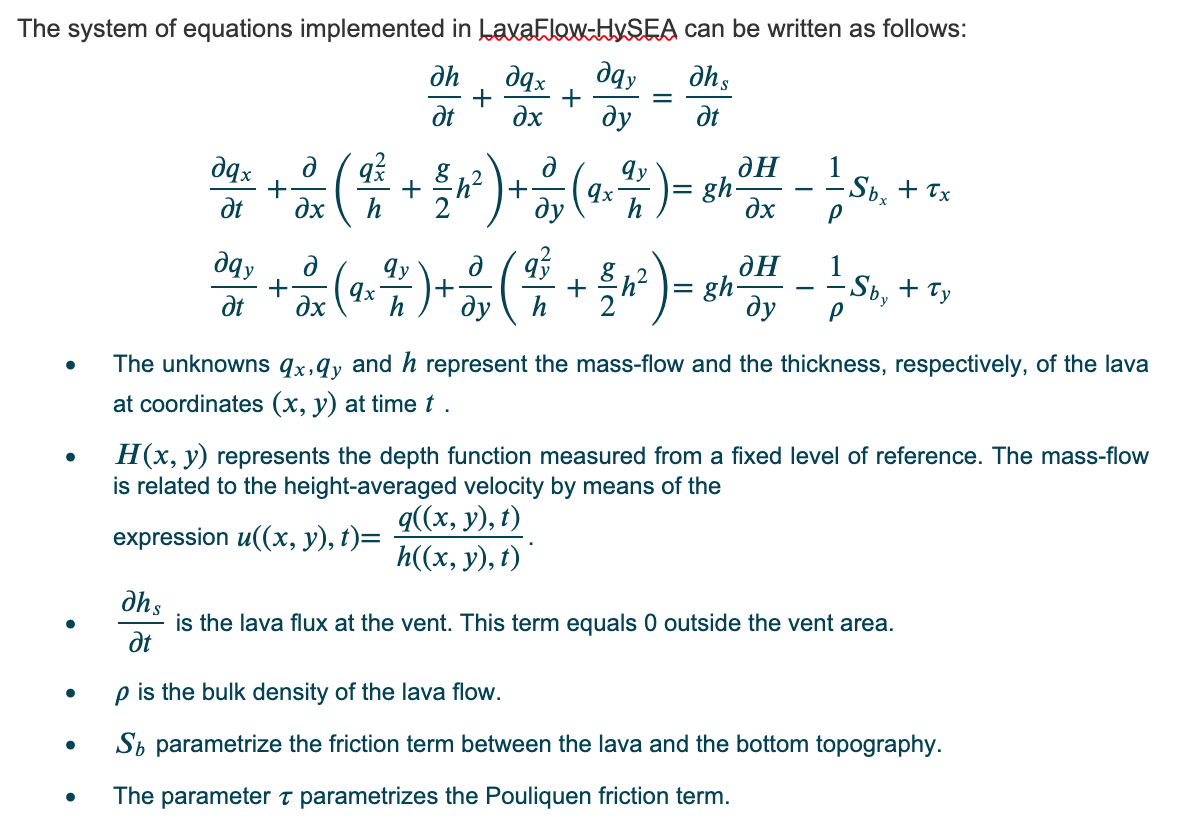
The kind of simplify depth-average models that we are proposing to use, for which the behavior of the lava flow is reproduced under a number of simplifying hypotheses has been extensively used in studies for prediction of the emplacement of volcanic mass flows (Costa, 2005; Macedonio, et al., 2005; Kelfoun and Druitt, 2005; Kelfoun and Vallejo, 2015; Bernabeu, et al., 2013; among many others). The advantages of such models include moderate computational cost (extremely reduced if we compared with fully 3D models), and producing accurate results (Cordonier et al., 2015). Drawbacks include the necessity to assume a constant viscosity value along the vertical profile and that they simulate an isothermal flow. In any case, the depth-average models have proven to be able to simulate the velocity of the lava through time and the extent of the solidified lava (Kelfoun and Vallejo, 2015; Cordonier et al., 2015).
References
Bernabeu, N., Saramito, P. and Smutek, C. 2013. Numerical modeling of non-Newtonian viscoplastic flows: Part II. viscoplastic fluids and general tridimensional topographies. International Journal of Numerical Analysis & Modeling, 11, 214–229.
Cordonnier, B., Lev, E. and Garel, F. (2015). Benchmarking lava flow models. Geological Society, London, Special Publications, 426, 425-445, https://doi.org/10.1144/SP426.7
Costa, A. 2005. Viscosity of high crystal content melts: dependence on solid fraction. Geophysical Research Letters, 32, L22308, http://doi.org/10.1029/2005GL024303
Fernández.Nieto, E.D., Bouchut, F., Bresh, D., Castro, M.J. and, Mangeney, A. (2008). A new Savage-Hutter type model for submarine avalanches and generated tsunami. J. Comp. Phys., 227: 7720-7754.
Kelfoun, K. and Druitt, T. 2005. Numerical modeling of the emplacement of Socompa Rock Avalanche, Chile. Journal of Geophysical Research: Solid Earth, 110, B12202, http://doi.org/10.1029/2005JB003758
Kelfoun, K. and Vallejo Vargas, S. 2015. VolcFlow capabilities and perspectives of development for the simulation of lava flows. In: Harris, A. J. L., De Groeve, T., Garel, F.&Carn, S. A. (eds) Detecting, Modelling and Responding to Effusive Eruptions. Geological Society, London, Special Publications, 426. http://doi.org/10.1144/SP426.8
Macedonio, G., Costa, A. and Longo, A. 2005. A computer model for volcanic ash fallout and assessment of subsequent hazard. Computers & Geosciences, 31, 837–845.
Pouliquen, O. (1999) "Scaling laws in granular flows down rough inclined planes", Physics of Fluids, 11, 542-548 https://doi.org/10.1063/1.869928
Savage, S.B. and Hutter, K. (1989). The motion of a finite mass of granular material down a rough incline. J. of Fluid Mechanics, 199, 177-215.
